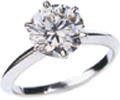Loose Diamonds
Diamond Guides
- The 4 C's and More
- Diamond Shape
- Diamond Cut
- Diamond Color
- Diamond Clarity
- Diamond Carat Size
- GIA Certification
- GIA Cut Grades
Jewelry Guides
- Engagement Ring Guide
- Diamond Tips
- Caring For Your Jewelry
- Tips on Getting Her Ring Size
- How To Build Your Fine Diamond Jewelry Wardrobe
- Diamond & Jewelry Appraisals
- Branded Diamonds
Education Videos
Design Your Engagement Ring
A. Fishman Difference
- Direct Diamond Prices
- Loose Diamond Manufacturer
- A+ Rating From BBB
- Customer Testimonials
- 100% Money Back Guarantee
- FREE FedEx Overnight Shipping
- Lifetime Warranty
- 2% Discount for Bank Wires
- Why No "Shopping Cart"
Expert Guidance
- Expert Guidance
- 212-869-0085
How to Tell if a Diamond Is Real
Before you begin shopping, make sure you know how to tell if a diamond is real. To avoid being fooled by an imitation, put your trust in a reputable diamond buyer. You can learn about a diamond’s authenticity through a certification report and an inspection by an experienced diamantaire, such as our owner Joshua Fishman. All of our diamond certifications come from the Gemological Institute of America (GIA), which follows strict grading standards. Certification details provide information on a diamond’s weight, measurements, and other properties. Today there are man-made diamonds, cultured diamonds, synthetic diamonds, and lab created diamonds. And sometimes natural diamonds will be cosmetically enhanced. If you want a natural, non-enhanced loose diamond, we’re here to assist you. Of course, it can help to understand that a cubic zirconia stone weighs more than the same size diamond, or that a glass stone sparkles less. However, to know if a mounted or loose diamond is real and has value, you should trust A. Fishman & Son.
Identify the Differences Between Real and Fake Diamonds at Home Before You Buy
Understand the sparkle in your hand. Learn to identify and spot the differences between real and fake diamonds. Real diamonds have unique characteristics:
• Breathe on a clean diamond. If the fog clears immediately, it’s probably real.
• Check for tiny diamond imperfections called inclusions. They’re often missing from fakes.
• See a genuine diamond reflect gray shades, rather than rainbows.
• Check the mounting. An imposter may be set in an inferior one.
• Hold a loose diamond over a typed paper. Can you see the print? It’s not real.
With our extensive experience, A. Fishman & Son will help you identify the exact differences between real and fake diamonds. Give us a call with your questions.
Be on the Lookout for Synthetic or "Lab Created Diamonds"
An even more problematic situation arises in the case of lab grown diamonds vs real diamonds. All such "diamonds" are, by law, supposed to be identified as such. In fact, the International Gemological Laboratory (IGI) issues "certificates" which identify such "diamonds" as "laboratory grown." These synthetic diamonds sell for about 35% less than natural diamonds (the "real thing"). The problem with these "laboratory grown diamonds" is two-fold:
- While these types of artificial diamonds will sell for just a little less than the "real thing," their value for resale is non-existent. No diamond dealer will buy these back from you or take them as a trade in. And the sellers (including the creators) of these diamonds will also refuse to buy them back from you beyond their 30 or 60 day refund policy.
- Many of these laboratory grown diamonds and other synthetics are being marketed without disclosure, leaving you, the consumer, at great risk. The New York Diamond Dealers Club has just (June 2012) issued a warning about this.
Your best protection against being "taken" is to consult with an experienced diamantaire, like A. Fishman & Son, who can help you navigate the treacherous waters of synthetics and fake diamonds.
Loose Diamonds
Shapes of Diamonds
Diamond Videos-New
About our Loose Diamonds
Perfect Diamonds
Pretty Diamonds
Round Cut
Princess Cut
Cushion Cut
Radiant Cut
Emerald Cut
Asscher Cut
Pear Shape
Oval Shape
Marquise Shape
Heart Shape
Diamond Jewelry
Brooches
Bracelets
Earrings
Engagement
Necklaces and Pendants
Wedding Rings
Custom Designed Jewelry
Diamond Guides
Diamond Guide - The 4 C's
Ethics of Lab-Grown Diamonds
Purchase: Beyond the Four C's
Diamond Guide Videos
Engagement Ring Guide
Understanding GIA Certificates
Understanding GIA Cut Grades
Pretty Diamonds
Diamond Clarity Enhancements
Conflict Free Diamonds
Identifying Fake Diamonds
Diamond Tips
Diamond Jewelry Appraisals
Diamond & Jewelry Care
Gift Giving
Beyond the 4 C's
Jewelry and Diamonds to Wear for a Lifetime - Not Just a Season!™
 A. Fishman & Son • 580 Fifth Avenue, Ste 402 • New York, NY 10036 • 212-869-0085
A. Fishman & Son • 580 Fifth Avenue, Ste 402 • New York, NY 10036 • 212-869-0085
Copyright © 2011-2022 A.Fishman & Son. All Rights Reserved. Website by YLWConsulting




